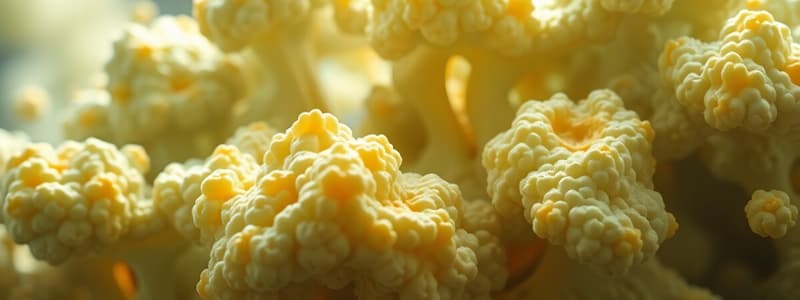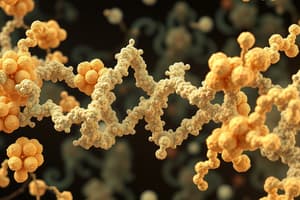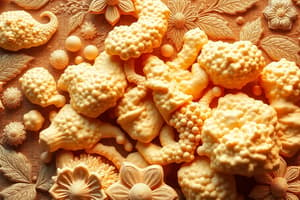Podcast
Questions and Answers
What type of protein is albumin considered to be?
What type of protein is albumin considered to be?
- Incomplete protein
- High biological value protein (correct)
- Structural protein
- Low biological value protein
Which of the following proteins is coagulated by heat?
Which of the following proteins is coagulated by heat?
- Lactalbumin
- Gelatin
- Serum globulin
- Egg albumin (correct)
What is the primary source of gelatin?
What is the primary source of gelatin?
- Plant proteins boiled in water
- Colloidal vegetable matter
- Ground animal bones
- Animal tissues by boiling skin (correct)
Which of the following proteins lacks one or more essential amino acids?
Which of the following proteins lacks one or more essential amino acids?
Which characteristic is NOT true for serum globulin?
Which characteristic is NOT true for serum globulin?
Which of the following is NOT a characteristic of gelatin?
Which of the following is NOT a characteristic of gelatin?
Which protein is rich in basic amino acids and supports connective tissue?
Which protein is rich in basic amino acids and supports connective tissue?
What term describes the change in protein structure from liquid to solid or thicker liquid?
What term describes the change in protein structure from liquid to solid or thicker liquid?
Which protein is found predominantly in animal tissues and is known for not being present in plants?
Which protein is found predominantly in animal tissues and is known for not being present in plants?
Which of the following is an example of a basic protein rich in amino acids?
Which of the following is an example of a basic protein rich in amino acids?
Which type of conjugated protein is associated with carbohydrates?
Which type of conjugated protein is associated with carbohydrates?
Which of the following best describes a simple protein?
Which of the following best describes a simple protein?
What is the primary function of lipoproteins in the body?
What is the primary function of lipoproteins in the body?
Which of the following is an example of a metalloprotein?
Which of the following is an example of a metalloprotein?
What distinguishes the C-terminal from the N-terminal in a polypeptide chain?
What distinguishes the C-terminal from the N-terminal in a polypeptide chain?
Which of the following is NOT considered a biological function of proteins?
Which of the following is NOT considered a biological function of proteins?
Which non-protein part is associated with phosphoproteins?
Which non-protein part is associated with phosphoproteins?
What is the main protein found in milk?
What is the main protein found in milk?
What type of protein is hemoglobin classified as?
What type of protein is hemoglobin classified as?
Which of the following example proteins is involved in iron transport?
Which of the following example proteins is involved in iron transport?
Which of the following proteins is primarily classified as an albuminoid?
Which of the following proteins is primarily classified as an albuminoid?
What characterizes conjugated proteins in contrast to simple proteins?
What characterizes conjugated proteins in contrast to simple proteins?
Which type of conjugated protein includes antibodies as an example?
Which type of conjugated protein includes antibodies as an example?
During the hydrolysis of a protein, what is primarily produced?
During the hydrolysis of a protein, what is primarily produced?
What role do glycoproteins play in the immune system?
What role do glycoproteins play in the immune system?
Which of the following statements about immunoglobulins is false?
Which of the following statements about immunoglobulins is false?
Which of the following is categorized under conjugated proteins due to its lipid component?
Which of the following is categorized under conjugated proteins due to its lipid component?
Which of the following is NOT a common type of simple protein?
Which of the following is NOT a common type of simple protein?
Which non-protein part is found in metalloproteins that is necessary for their function?
Which non-protein part is found in metalloproteins that is necessary for their function?
A protein hormone is primarily involved in which of the following functions?
A protein hormone is primarily involved in which of the following functions?
What is a characteristic of hemoproteins?
What is a characteristic of hemoproteins?
Which type of protein is defined as having no peptide bond break?
Which type of protein is defined as having no peptide bond break?
What occurs during the action of hydrolyzing agents on proteins?
What occurs during the action of hydrolyzing agents on proteins?
Which of the following is a product of protein hydrolysis?
Which of the following is a product of protein hydrolysis?
What type of proteins require coenzymes such as FAD/FMN?
What type of proteins require coenzymes such as FAD/FMN?
Which of the following combinations correctly describes nucleoproteins?
Which of the following combinations correctly describes nucleoproteins?
Which type of derived protein is specifically produced by chemical denaturation of proteins?
Which type of derived protein is specifically produced by chemical denaturation of proteins?
Which of the following statements accurately describes flavoproteins?
Which of the following statements accurately describes flavoproteins?
What happens to the molecular weight (MW) of proteins during their hydrolysis?
What happens to the molecular weight (MW) of proteins during their hydrolysis?
What is a common function of hemoproteins in the body?
What is a common function of hemoproteins in the body?
Flashcards
Protein definition
Protein definition
Complex organic nitrogenous compounds formed from amino acid chains.
Protein monomer
Protein monomer
Amino acids, linked by peptide bonds.
Protein function
Protein function
Proteins have many vital roles like enzymes, hormones, and structural components.
Simple proteins
Simple proteins
Signup and view all the flashcards
Conjugated proteins
Conjugated proteins
Signup and view all the flashcards
Derived proteins
Derived proteins
Signup and view all the flashcards
Peptide bond
Peptide bond
Signup and view all the flashcards
Amino Acids
Amino Acids
Signup and view all the flashcards
Protein Structure
Protein Structure
Signup and view all the flashcards
Protein C-terminal end
Protein C-terminal end
Signup and view all the flashcards
Egg Albumin
Egg Albumin
Signup and view all the flashcards
Milk proteins
Milk proteins
Signup and view all the flashcards
Blood Albumin
Blood Albumin
Signup and view all the flashcards
Coagulation
Coagulation
Signup and view all the flashcards
Gelatin
Gelatin
Signup and view all the flashcards
High biological value protein
High biological value protein
Signup and view all the flashcards
Low biological value protein
Low biological value protein
Signup and view all the flashcards
Essential amino acids
Essential amino acids
Signup and view all the flashcards
Biological Value of Protein
Biological Value of Protein
Signup and view all the flashcards
Example of Glycoprotein
Example of Glycoprotein
Signup and view all the flashcards
Lipoprotein function
Lipoprotein function
Signup and view all the flashcards
Caseinogen
Caseinogen
Signup and view all the flashcards
Ceruloplasmin function
Ceruloplasmin function
Signup and view all the flashcards
Transferrin function
Transferrin function
Signup and view all the flashcards
VLDL
VLDL
Signup and view all the flashcards
Phosphoprotein
Phosphoprotein
Signup and view all the flashcards
Metalloprotein example
Metalloprotein example
Signup and view all the flashcards
Function of Glycoprotein
Function of Glycoprotein
Signup and view all the flashcards
What is the difference between simple proteins and conjugated proteins?
What is the difference between simple proteins and conjugated proteins?
Signup and view all the flashcards
What are chromoproteins?
What are chromoproteins?
Signup and view all the flashcards
Hemoglobin
Hemoglobin
Signup and view all the flashcards
Myoglobin
Myoglobin
Signup and view all the flashcards
Flavoproteins
Flavoproteins
Signup and view all the flashcards
Nucleoproteins
Nucleoproteins
Signup and view all the flashcards
What are the two main types of derived proteins?
What are the two main types of derived proteins?
Signup and view all the flashcards
Primary Protein Derivatives
Primary Protein Derivatives
Signup and view all the flashcards
Secondary Protein Derivatives
Secondary Protein Derivatives
Signup and view all the flashcards
Study Notes
Protein Types
- Proteins are organic complex nitrogenous compounds
- Formed by polymers of amino acids
- Amino acids are connected by peptide links (-CO-NH-)
- Proteins are the most complex biological molecules
- Formed of C, H, O, N (+/- Sulfur)
- The ends of a polypeptide chain are:
- COOH group: called the C-terminal end
- NH2 group: called the N-terminal end
Biological Importance of Proteins
- Enzymes
- Hormones (protein hormones)
- Plasma proteins
- Immunoglobulins (antibodies)
- Receptors
- Hemoglobin
- Lipoproteins
- Supporting structure (cartilage, bone, skin, hair, etc.)
Classification of Proteins
-
Simple proteins: Formed only of amino acids
-
Conjugated (compound) proteins: Protein + non-protein part
-
Derived proteins: Hydrolysis products of simple or conjugated proteins
- Primary derived proteins: Products of denaturation
- No hydrolysis
- No change in molecular weight
- Examples: coagulated albumin, coagulated globulin
- Secondary derived proteins: Products of progressive protein hydrolysis
- Change in molecular weight
- Examples: proteose, peptone, peptide, amino acids
- Primary derived proteins: Products of denaturation
High and Low Biological Value Proteins
- High biological value proteins: Contain all essential amino acids (e.g., casein of milk, albumin, globulin)
- Low biological value proteins: Lack one or more essential amino acids (e.g., gelatin, gliadin, vegetable proteins)
Conjugated (Compound) Proteins - Examples
- Glycoproteins: Protein + Carbohydrates (e.g., hormones, antibodies, blood group antigens)
- Lipoproteins: Protein + Lipid (e.g., chylomicrons, VLDL, LDL, HDL)
- Phosphoproteins: Protein + Phosphoric acids (e.g., caseinogen)
- Metalloproteins: Protein + Metals (e.g., ceruloplasmin, transferrin, ferritin)
- Chromoproteins: Protein + Pigment (e.g., hemoglobin, myoglobin)
- Nucleoproteins: Protein + Nucleic acids (e.g., chromatin, ribosome)
Gelatin
- Obtained from collagen by boiling
- Forms a gel by cooling
- Easily digested
- Not an adequate diet (low biological value, deficient in some amino acids, especially tryptophan)
References
- Vasudevan's Textbook of Medical Biochemistry For Students, 7th Edition
- Chatterjea's Textbook of Medical Biochemistry, 8th edition
- Lippincott's Illustrated Biochemistry, 8th edition
Studying That Suits You
Use AI to generate personalized quizzes and flashcards to suit your learning preferences.




